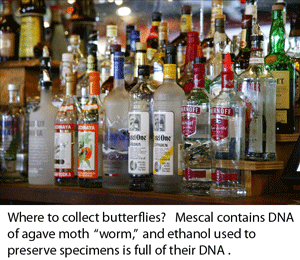It used to be standard practice to shave the area around the incision before surgery, as it was thought that hair harbored bacteria that would cause wound infection. Beginning in the 1970s, doctors found this was unnecessary, and in fact was associated with higher incidence of post-operative infection. This history comes to mind in reading March 2010 BioTechniques report by researchers from University of Guelph demonstrating that DNA suitable for PCR and sequencing can be obtained simply by leaving specimens in alcohol overnight!
 Of the three steps required to get from a specimen to a DNA barcode, namely DNA isolation, PCR (polymerase chain reaction), and sequencing, the first step is the most labor intensive and hardest to automate. Numerous protocols/kits have been developed to optimize DNA isolation from various types of specimens, such as plant vs animal tissues. As described by the Guelph researchers, “these procedures force cells to release their DNA via physical pertubation and/or chemical treatment, which is then followed by a clean-up procedure in which unwanted cellular compoents are separated from the DNA.” The researchers “hypothesized that a small amount of DNA leaks from the tissue into the preservation solution (usually ethanol), and that this DNA was amplifiable using a standard PCR protocol.” To start, they analyzed Monte Alban mescal, which is sold with a “worm” (a caterpillar of the agave moth, Hypopta agavis) in each bottle. They evaporated 50 mL mescal, re-dissolved the residue in water, applied this to a Qiagen MinElute spin column, resuspended the product in 50 ?L water, and used 2 ?L of resulting solution in a standard 25 ?L PCR reaction, with successful amplification and sequencing of 130 base mini-barcode of COI. This case was presumably challenging as mescal is only 40% ethanol and contains a variety of material that might inhibit PCR. In subsequent tests, 1 mL of 95% ethanol used to preserve specimens was evaporated, resuspended in 30 ?L of water without column purification, and 2 ?L used for PCR.
Of the three steps required to get from a specimen to a DNA barcode, namely DNA isolation, PCR (polymerase chain reaction), and sequencing, the first step is the most labor intensive and hardest to automate. Numerous protocols/kits have been developed to optimize DNA isolation from various types of specimens, such as plant vs animal tissues. As described by the Guelph researchers, “these procedures force cells to release their DNA via physical pertubation and/or chemical treatment, which is then followed by a clean-up procedure in which unwanted cellular compoents are separated from the DNA.” The researchers “hypothesized that a small amount of DNA leaks from the tissue into the preservation solution (usually ethanol), and that this DNA was amplifiable using a standard PCR protocol.” To start, they analyzed Monte Alban mescal, which is sold with a “worm” (a caterpillar of the agave moth, Hypopta agavis) in each bottle. They evaporated 50 mL mescal, re-dissolved the residue in water, applied this to a Qiagen MinElute spin column, resuspended the product in 50 ?L water, and used 2 ?L of resulting solution in a standard 25 ?L PCR reaction, with successful amplification and sequencing of 130 base mini-barcode of COI. This case was presumably challenging as mescal is only 40% ethanol and contains a variety of material that might inhibit PCR. In subsequent tests, 1 mL of 95% ethanol used to preserve specimens was evaporated, resuspended in 30 ?L of water without column purification, and 2 ?L used for PCR.
By evaporating 1 mL of ethanol in which specimens had been stored overnight (out of 2 mL total ethanol volume) and re-suspending residue in water, Shokralla and colleagues amplified and sequenced 130-base and 650-base fragments of COI and 1100-base fragment of 28s RNA from 25 whole insect specimens (mayflies, caddisflies; 1 gave COI only) and rbcL from 45 plant specimens (0.5 mm leaf samples). They also obtained COI sequences by sampling 1 mL of ethanol solution from 7 insect specimens stored at room temperature for 7 to 10 years. The researchers note this approach could facilitate for “high-throughput” analyses, as it involves liquid handling which is easy to automate, avoids destructive sampling, and could be used even when “there is simply no sample left for further analysis.” They conclude with a caution about “field sampling procedures that include placing mixtures of specimens in an ethanol jar” as this “may increase the chance of cross-contamination.”
The remarkably simple procedure reported by Shokralla and colleagues offers benefits to many persons who want to get DNA barcode identifications. I look forward to applications of this method in research and commercial laboratories, classrooms, and perhaps kitchens!
Interesting. During my PhD I worked on complete mtDNA sequencing in insects. We actually found that specimens preserved in ethanol gave quite poor quality DNA compared to dried/pinned specimens. Maybe the amount of DNA released into the ethanol over time makes it a better source than the insect itself?